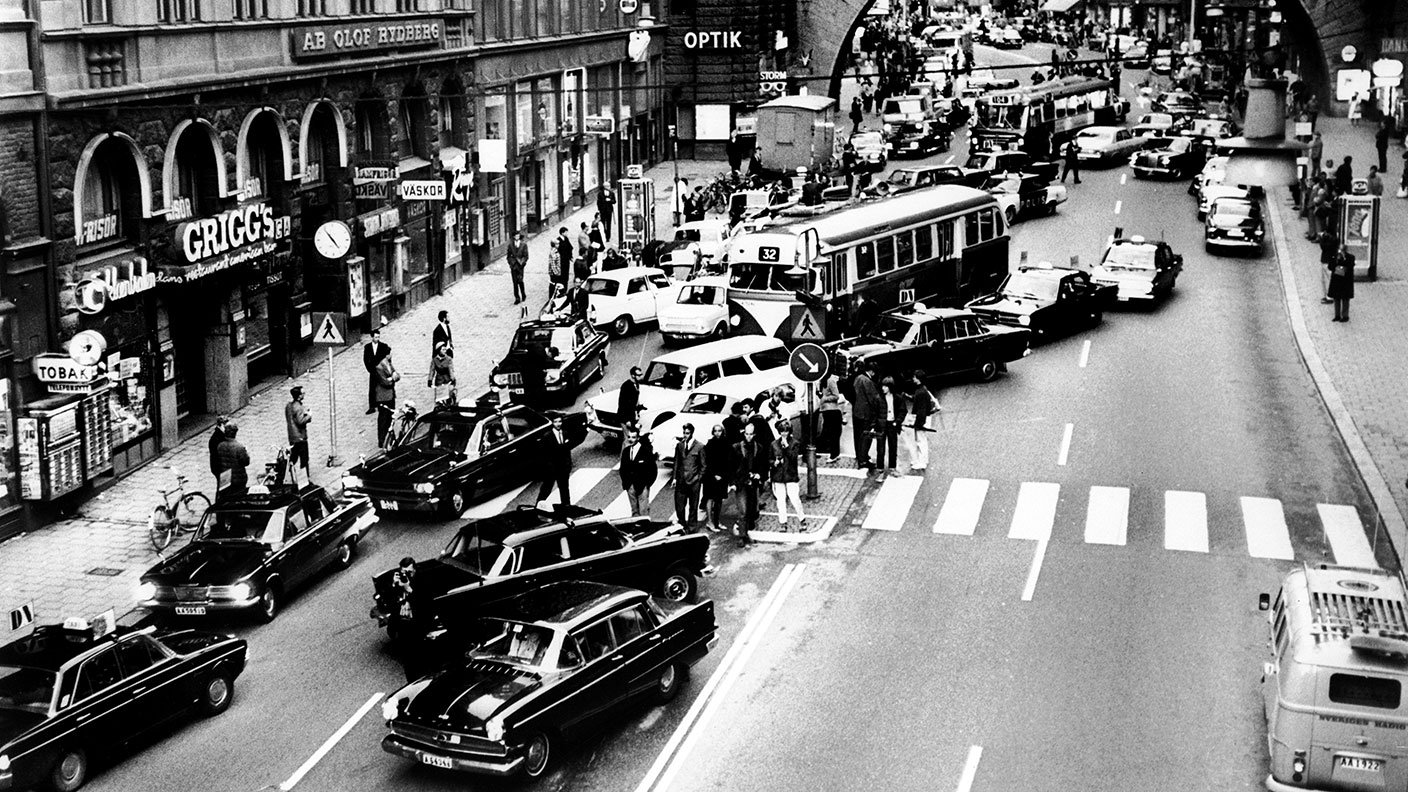3 September 1967: Sweden switches to driving on right-hand side of the road
This day in 1967 was known as ‘Högertrafikomläggningen’ in Sweden. It was the day the country switched from driving on the left side of the road to driving on the right.

This day in Sweden in 1967 was known as Hgertrafikomlggningen – the “right-hand traffic diversion”. Also called Dagen-H, it was the day the country switched from driving on the left side of the road to driving on the right.
While the rest of mainland Europe had settled on driving on the right hand side of the road, Sweden decided it preferred the left. This caused problems. People had to switch from left to right at the borders with Norway and Finland, plus – oddly – virtually every car in Sweden at the time was left-hand drive. Nevertheless, Swedes seemed to like it that way.
The government first proposed changing over to the right as early as 1920, but was met with stiff resistance. But it kept on debating it every year. In 1955, it held a referendum – 83% of the population said they'd rather stick on the left, thanks.
MoneyWeek
Subscribe to MoneyWeek today and get your first six magazine issues absolutely FREE

Sign up to Money Morning
Don't miss the latest investment and personal finances news, market analysis, plus money-saving tips with our free twice-daily newsletter
Don't miss the latest investment and personal finances news, market analysis, plus money-saving tips with our free twice-daily newsletter
But after a while, the government thought they'd just get on and do it. So in 1963, the switch was approved, and the Statens Hgertrafikkommission was set up to administer the change. A huge PR campaign was set up to get Swedes used to the idea. Junctions were redesigned, and 360,000 new signs put up in preparation.
And so, at 4:50 AM on Sunday 3 September 1967, all traffic was ordered to come to a standstill for ten minutes. Then, at 5:00 AM, everyone switched sides.
Boringly, chaos did not ensue. This was Sweden, after all. Everyone behaved themselves, and the accident rate fell. Insurance claims dropped by 40%, only returning to their previous levels after two years.
Sweden isn't the only country to change sides, of course. Iceland followed suit in 1968, and a whole host of former British colonies in West Africa did it in the 1970s. But it's not all one-way traffic. Samoa switched from right to left in 2009.
Get the latest financial news, insights and expert analysis from our award-winning MoneyWeek team, to help you understand what really matters when it comes to your finances.
Ben studied modern languages at London University's Queen Mary College. After dabbling unhappily in local government finance for a while, he went to work for The Scotsman newspaper in Edinburgh. The launch of the paper's website, scotsman.com, in the early years of the dotcom craze, saw Ben move online to manage the Business and Motors channels before becoming deputy editor with responsibility for all aspects of online production for The Scotsman, Scotland on Sunday and the Edinburgh Evening News websites, along with the papers' Edinburgh Festivals website.
Ben joined MoneyWeek as website editor in 2008, just as the Great Financial Crisis was brewing. He has written extensively for the website and magazine, with a particular emphasis on alternative finance and fintech, including blockchain and bitcoin.
As an early adopter of bitcoin, Ben bought when the price was under $200, but went on to spend it all on foolish fripperies.
-
 My 6.5% Nationwide regular saver is due to mature - what are my options?
My 6.5% Nationwide regular saver is due to mature - what are my options?Nationwide’s 6.5% regular saver is due to mature for those who opened one last year. Here is what you can do now to make the most of your savings
-
 Leading European companies offer long-term growth
Leading European companies offer long-term growthOpinion Alexander Darwall, lead portfolio manager, European Opportunities Trust, picks three European companies where he'd put his money
-
 31 August 1957: the Federation of Malaya declares independence from the UK
31 August 1957: the Federation of Malaya declares independence from the UKFeatures On this day in 1957, after ten years of preparation, the Federation of Malaya became an independent nation.
-
 13 April 1960: the first satellite navigation system is launched
13 April 1960: the first satellite navigation system is launchedFeatures On this day in 1960, Nasa sent the Transit 1B satellite into orbit to provide positioning for the US Navy’s fleet of Polaris ballistic missile submarines.
-
 9 April 1838: National Gallery opens in Trafalgar Square
9 April 1838: National Gallery opens in Trafalgar SquareFeatures On this day in 1838, William Wilkins’ new National Gallery building in Trafalgar Square opened to the public.
-
3 March 1962: British Antarctic Territory is created
Features On this day in 1962, Britain formed the British Antarctic Territory administered from the Falkland Islands.
-
10 March 2000: the dotcom bubble peaks
Features Tech mania fanned by the dawning of the internet age inflated the dotcom bubble to maximum extent, on this day in 2000.
-
9 March 1776: Adam Smith publishes 'The Wealth of Nations'
Features On this day in 1776, Adam Smith, the “father of modern economics”, published his hugely influential book The Wealth of Nations.
-
 8 March 1817: the New York Stock Exchange is formed
8 March 1817: the New York Stock Exchange is formedFeatures On this day in 1817, a group of brokers moved out of a New York coffee house to form what would become the biggest stock exchange in the world.
-
7 March 1969: Queen Elizabeth II officially opens the Victoria Line
Features On this day in 1969, Queen Elizabeth II took only her second trip on the tube to officially open the underground’s newest line – the Victoria Line.

